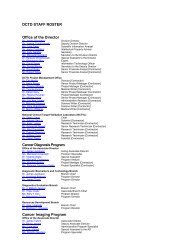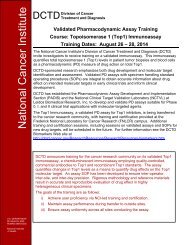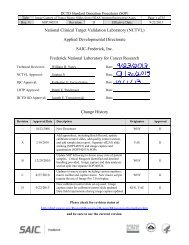National Cancer Institute - NCI Division of Cancer Treatment and ...
National Cancer Institute - NCI Division of Cancer Treatment and ...
National Cancer Institute - NCI Division of Cancer Treatment and ...
Create successful ePaper yourself
Turn your PDF publications into a flip-book with our unique Google optimized e-Paper software.
Evaluating <strong>Treatment</strong> Effects in<br />
the Presence <strong>of</strong> Competing Risks<br />
Competing risks are <strong>of</strong>ten encountered<br />
in clinical research. For example, a cancer<br />
patient may experience local failure or<br />
distant failure, or die without recurrence.<br />
In comparing treatments, use <strong>of</strong> endpoints<br />
based on the type <strong>of</strong> failure directly<br />
related to the treatment mechanism <strong>of</strong><br />
action allows one to focus on the aspect<br />
<strong>of</strong> the disease targeted by treatment.<br />
Drs. Friedlin <strong>and</strong> Korn evaluate statistical<br />
methodology commonly used for testing<br />
failure-specific treatment effects. The<br />
article demonstrates that the cause-<br />
specific log-rank test is superior to the<br />
cumulative incidence-based approach.<br />
Freidlin B, Korn EL. Testing treatment effects<br />
in the presence <strong>of</strong> competing risks. Stat Med<br />
2005:24;1703–12.<br />
Longitudinal Data Analysis<br />
Drs. Albert <strong>and</strong> Hunsberger have continued<br />
a productive research program to<br />
develop new methods for the analysis <strong>of</strong><br />
longitudinal data. Most <strong>of</strong> this work has<br />
been motivated by problems in analyzing<br />
repeated biomarker measurements over<br />
time. A new methodology for analyzing<br />
longitudinal data based on a serial dilution<br />
assay was applied to data from a clinical<br />
trial examining the effect <strong>of</strong> acupuncture<br />
on reducing nausea associated with breast<br />
cancer treatment.<br />
Albert PS, Shen J. Modeling longitudinal semicontinuous<br />
emesis volume data with serial<br />
correlation in an acupuncture clinical trial.<br />
J R Stat Soc Ser C Appl Stat 2005:54;707–20.<br />
Albert PS. On the interpretation <strong>of</strong> marginal<br />
inference with a mixture model for clustered<br />
semi-continuous data. Biometrics 2005:61;<br />
879–80.<br />
Albert PS. Hunsberger S. On analyzing circadian<br />
rhythm data using non-linear mixed models with<br />
harmonic terms. Biometrics 2005:61;1115–22.<br />
Albert PS, Follmann DA. R<strong>and</strong>om effects <strong>and</strong><br />
latent process approaches for longitudinal<br />
binary data with missingness: with applications<br />
to the analysis <strong>of</strong> opiate clinical trial data. To<br />
appear in Stat Methods Med Res.<br />
Evaluating Diagnostics in the<br />
Absence <strong>of</strong> a Gold St<strong>and</strong>ard<br />
In 2004, Drs. Dodd <strong>and</strong> Albert published<br />
a paper on potential problems from<br />
estimating the diagnostic error <strong>of</strong> binary<br />
tests without a gold st<strong>and</strong>ard using latent<br />
class modeling. They showed that these<br />
approaches are sensitive to the dependence<br />
structure between tests, yet it is<br />
generally nearly impossible to distinguish<br />
between competing models. In a followup<br />
paper, they examine the robustness<br />
<strong>of</strong> the estimation procedures when, in<br />
a fraction <strong>of</strong> cases, we observe the gold<br />
st<strong>and</strong>ard test. They propose semi-latent<br />
modeling approaches for this problem<br />
<strong>and</strong> show that, even with a small percentage<br />
<strong>of</strong> gold st<strong>and</strong>ard information, estimates<br />
<strong>of</strong> diagnostic error are insensitive<br />
to the assumed dependence structure<br />
between tests.<br />
Albert PS, Dodd LA. Cautionary note on the<br />
robustness <strong>of</strong> latent class models for estimating<br />
diagnostic error without a gold st<strong>and</strong>ard.<br />
Biometrics 2004:60;427–35.<br />
Albert PS, Dodd L. On estimating diagnostic<br />
accuracy from studies with multiple raters <strong>and</strong><br />
partial gold st<strong>and</strong>ard evaluation. In revision at<br />
J Am Stat Assoc.<br />
Albert PS. An imputation approach for estimating<br />
diagnostic accuracy from partially verified<br />
designs. Submitted to Biometrics.<br />
Albert PS. Misclassification models. In: Encyclopedia<br />
<strong>of</strong> Biostatistics. 2nd ed. Armitage P, Colton T,<br />
eds. New York: John Wiley & Sons; 2005.<br />
B I O M E T R I C R E S E A R C H B R A N C H ■ 23










